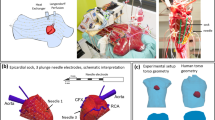Abstract
Background: Magnetocardiography (MCG) has the potential for collecting three-dimensional (3D) intracardiac electric information, because the magnetic field is unaffected by the shape of the lungs and torso. In the present study, we report on the generation of a 3D heart outline and conduction pathway by means of a current density map using a 64-channel SQUID system, and an evaluation of its significance in patients with atrial flutter (AFL) and atrial fibrillation (AFIB) Methods: The subjects consisted of 20 healthy volunteers, and 3 patients with AFL and 4 patients with AFIB. A 64-channel MCG was recorded after digitization at 500 Hz, and a 3D current density was reconstructed from the magnetic fields using a space filter in conjunction with the minimum normalization method of Tikhonov. A 3D heart outline was generated from the integrated current density by the space filter. The conduction pathway was superimposed on a heart outline generated by a magnetic field. The heart outline was verified by the silhouette on the magnetic resonance (MR) images. An MCG was recorded pre- and post interventional therapy, and therapeutic efficacy was evaluated. Results: The 3D heart outline of the atrium and ventricle corresponded to the silhouette of the right atrium and left ventricle, respectively, on an MR image. The serial conduction pathway of the QRS segment superimposed on the 3D heart outline map demonstrated the conduction pattern generated within the heart. The MCG revealed a counter-clockwise rotation in patients with AFL, and random micro-reentry in the case of AFIB. After interventional therapy, restoration of the sinus rhythm was verified in patients with both AFL and AFIB. Conclusions: A 64-channel MCG was used to evaluate the 3D heart outline and conduction pathway in patients with AFL and AFIB without the need for MR images. Condensed Abstract A 64-channel MCG was used to evaluate the 3D heart out line and conduction pathway in patients with AFL and AFIB.
Similar content being viewed by others
References
D Cohen EA Edelsack JE Zimmaerman (1970) ArticleTitleMagnetocardiogram taken inside a shielded room with superconducting point-contact magnetometor Appl Phys 16 288–294
R Fenici K Pesola P Korhonen et al. (1998) ArticleTitleMagnetocardiographic pacemapping for nonfluoroscopic localization of intracardiac electrophysiology catheters Pacing Clin Electrophysiol 21 2492–2499 Occurrence Handle9825373
K Tsukada T Mitsui Y Terada H Horigome I Yamaguchi (1999) ArticleTitleNoninvasive visualization of multiple simultaneously activated regions on torso magnetocardiographic maps during ventricular depolarization J Electrocardiol 32 305–310 Occurrence Handle10.1016/S0022-0736(99)90001-8 Occurrence Handle10549906
Nakai K, Kawazoe K, Izumoto H, Suwabe A, Yoshizawa M. Three-dimensional electric current density map by 64-channel magnetocardiography in patients with atrial flutter and atrial fibrillation. In: Proceedings 14th Int Conf Biomagnetism 2004; 409–410
Simizu T, Nakai K, Ito M, Yoshizawa M. Sixty-four channels mcg and three-dimensional current density map. In: Proceedings 14th Int Conf Biomagnetism 2004; 347–348
M Haissaguerre P Jais DC Shah et al. (1998) ArticleTitleSpontaneous initiation of atrial fibrillation by ectopic beats originating in the pulmonary vein N Engl J Med 229 659–666 Occurrence Handle10.1056/NEJM199809033391003
T Arentz J Rosenthal Particlevon T Blum et al. (2003) ArticleTitleFeasibility and safety of pulmonary vein isolation using a new mapping and navigation system in patients with refractory atrial fibrillation Circulation 108 2484–2490 Occurrence Handle10.1161/01.CIR.0000097118.75179.83 Occurrence Handle14581401
Yoshizawa M, Nakai K, Nakamura Y, Kobayashi K, Uchikawa Y. Current density imaging of simulated MCG signal by Modified Synthetic Aperture Magnetometry. In: Proceedings of 13th Int Conf Biomagnetism 2002; 814
Yoshizawa M, Shimizu T, Itoh M, et al. On the optimization of spatial filter to costruct three-dimensional current density imaging from MCG signal. IN: Proceedings of 14th Int Conf Biomagnetism 2004; 352
Yamada S, Tsukada K, Miyashita T, Wan K, Yamaguchi I. Non-invasive stratification of micro-reentrant arrhythmia by using magnetocardiograms. In: Novak et al. Proceeding of 13th Int Conf Biomagnetism 2002; 554–556
PC Riberio AC Bruno PL Sboiae Silva (1992) ArticleTitleDetection of reentrant currents in atrial flutter by magnetocardiogrphy IEEE Trans Biomed Eng 39 818–824 Occurrence Handle10.1109/10.148389 Occurrence Handle1505995
J Vrba SE Robinson (2001) ArticleTitleSignal processing in magnetoencephalography Methods 25 249–271 Occurrence Handle10.1006/meth.2001.1238 Occurrence Handle11812209
Robinson SE, Vrba J. Functional neuroimaging by Synthetic Aperture Magnetometry (SAM) In: Yoshimoto T, Kotani M, Kuriki S, Karibe H, Nakasato N. (eds) Recent Advances in Biomagnetism, Tohoku University Press, 1999; 302–305
Pesola K, Nenonen J. Proceedings of 12th Int Conf Biomagnetism 2000; 835–838
S Willems C Weiss R Ventura et al. (2000) ArticleTitleCatheter ablation of atrial flutter guided by electroanatomic mapping (CARTO): a randomized comparison to the conventional approach J␣Cardiovasc Electrophysiol 11 1223–1230 Occurrence Handle10.1046/j.1540-8167.2000.01223.x Occurrence Handle11083243
J Kamata K Kawazoe H Izumoto et al. (1997) ArticleTitlePredictors of sinus rhythm restoration after Cox maze procedure concomitant with other cardiac operations Ann Thorac Surg 64 394–398 Occurrence Handle10.1016/S0003-4975(97)00139-2 Occurrence Handle9262582
H Izumoto T Kawase K Ishihara et al. (2001) ArticleTitleSurvival and sinus rhythm maintenance after modified Cox/maze procedure and mitral valve operation in patients with chronic atrial fibrillation Jpn J Thorac Cardiovasc Surg 49 58–61 Occurrence Handle10.1055/s-2001-9922 Occurrence Handle11233244
H Izumoto K Kawazoe K Eishi J Kamata (2000) ArticleTitleMedium-term results after the modified Cox/Maze procedure combined with other cardiac surgery Eur J Cardiothorac Surg 17 25–29 Occurrence Handle10.1016/S1010-7940(99)00346-2 Occurrence Handle10735408
J Kamata K Nakai N Chiba et al. (1997) ArticleTitleElectrocardiographic nature of restored sinus rhythm after Cox maze procedure in patients with chronic atrial fibrillation who also had other cardiac surgery Heart 77 50–55 Occurrence Handle9038695
J Jalife (2003) ArticleTitleRotors and spiral waves in atrial fibrillation J␣Cardiovasc Electrophysiol 14 776–780 Occurrence Handle12930260
Author information
Authors and Affiliations
Corresponding author
Rights and permissions
About this article
Cite this article
Nakai, K., Kawazoe, K., Izumoto, H. et al. Construction of a Three-dimensional Outline of the Heart and Conduction Pathway by Means of a 64-channel Magnetocardiogram in Patients with Atrial Flutter and Fibrillation. Int J Cardiovasc Imaging 21, 555–561 (2005). https://doi.org/10.1007/s10554-005-0652-1
Received:
Accepted:
Issue Date:
DOI: https://doi.org/10.1007/s10554-005-0652-1




